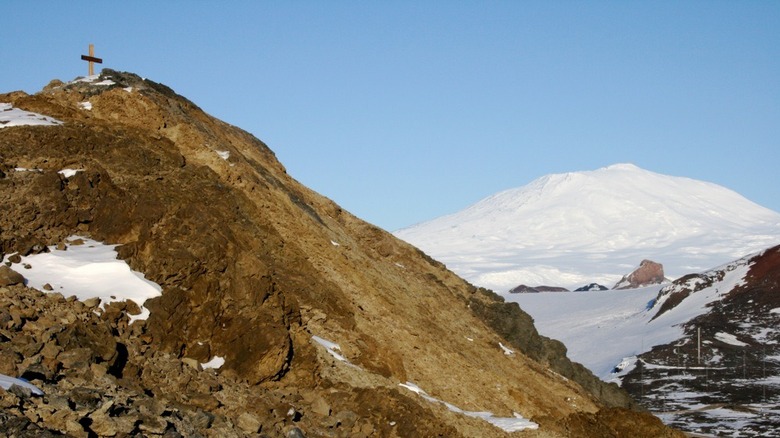

while the eastern summit rises to 5,621 meters. Topography Įlbrus is an almost symmetrical dormant volcano, in a vertical plane, with two main peaks, on either side of a pass located at 5,416 metres above sea level: the western summit is the highest point at 5,642 metres above sea level. Access permits are required south of Baksan because of border controls. Nationalpark Elbrus, which is accessed by the A158 road out of Baksan, lies on its southeastern flank. By road it is accessible from European route E50, known to Russians as either the M29 highway or the R217 highway. Įlbrus is located 65 kilometres southwest of the city of Kislovodsk and 80 kilometers west-southwest of Nalchik. It is the highest peak in both Russia and Europe. Located eleven kilometres north of the Greater Caucasus Watershed, marking the border with Georgia, it is shared between the respective territories of the Russian republics of Kabardino-Balkaria and Karachay-Cherkessia.
Mt. erebus wiki Patch#
The snow-capped ridges marking the watershed are visible as a white border Elbrus is the white patch to the north of it.Įlbrus is situated in the northwest of the Caucasus, 100 kilometres from the Black Sea and 370 kilometres from the Caspian Sea, from where it is possible to see it in exceptionally clear weather. The name "Mingi Taw" used by Karachays and Balkars means "Eternal Mountain" in Turkic. Harā may be interpreted as "watch" or "guard", from Indo-European * ser ("protect"). Bṛzatī is the feminine form of the adjective * bṛzant ("high"), the reconstructed ancestor of Modern Ossetian bærzond ("high", "peak"), Modern Persian barz ("high"), berāzande ("elegant"), and boland ("high", "tall"), and Modern Kurdish barz ("high"). Harā Bərəzaitī reflects Proto-Iranian * Harā Bṛzatī, which was reformed into Middle Persian as Harborz, and into Modern Persian as Alborz. The name is derived from Avestan Harā Bərəzaitī, a legendary mountain in Iranian mythology.

The name Elbrus / ˈ ɛ l b r ə s/ seems to have a connection with Alborz (also called Elburz), which is also the name of a long mountain range in northern Iran, but the two should not be confused. Crauford Grove and including Frederick Gardner, Horace Walker and the Swiss guide Peter Knubel. The eastern summit was first ascended on 10 July 1829 by Khillar Khachirov, and the western summit in 1874 by a British expedition led by F. The taller, western summit is 5,642 metres (18,510 ft) the eastern summit is 5,621 metres (18,442 ft). The mountain stands in Southern Russia, in the Russian republic of Kabardino-Balkaria.Įlbrus has two summits, both of which are dormant volcanic domes. The dormant volcano rises 5,642 m (18,510 ft) above sea level it is the highest stratovolcano in Eurasia, as well as the tenth-most prominent peak in the world.

It is situated in the western part of the Caucasus and is the highest peak of the Caucasus Mountains. Elbrus, IPA: Kabardian: Ӏуащхьэмахуэ, romanized: 'uaşhəmaxuə Karachay-Balkar: Минги тау, romanized: Mingi Taw) is the highest and most prominent peak in Russia and Europe. (Lower summit) 22 July 1829 by Khillar Khachirov (West summit) 1874, by Florence Crauford Grove, Frederick Gardner, Horace Walker and the guides Peter Knubel and Ahiya Sottaiev Kabardino-Balkaria and Karachay-CherkessiaĮlbrus and Upper Baksan Valley by EWP Location of Mount Elbrus on the Earth Show map of Earth


 0 kommentar(er)
0 kommentar(er)
